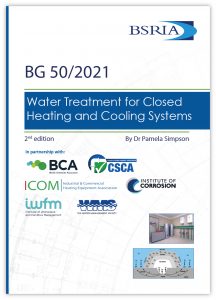Following the 2021 release of BSRIA’s 2nd edition of Water Treatment for Closed Heating and Cooling Systems (BG 50/2021), BSRIA engineering investigations lead, Chris Thompson, addresses frequently asked questions about what BG 50 is and how it relates to the VDI 2035 standard
What needs to be done to ensure the water quality in closed water systems doesn’t lead to deterioration and possibly failure?
This can be a complex subject and BSRIA Guide BG 50/2021 introduces the current theory and practice.
BG 50 applies to closed heating and cooling systems, providing guidance to achieve a well-maintained, functional closed water system. The guide includes a detailed outline of some of the methods and technologies used and provides an explanation of the science behind water quality and its importance in system maintenance. It is important to note that BG 50 is a guide and not a standard or regulation.
Should I use VDI 2035 or BG 50?
VDI 2035 and BG 50 should not be treated as comparable documents – they serve different purposes. Being aware of the differences between the documents is key to understanding and using each of them correctly.
VDI 2035 is a German standard, which has been widely used in Germany for many years and has grown in popularity in the UK, partly due to its non-chemical approach. There are currently two parts to VDI 2035, Part 1 and Part 3, with Part 2 having recently been withdrawn and its content included in the updated version of Part 1, which was published in March 2021.
VDI 2035 Part 1, Prevention of Damage in Water Heating Installations, Scale Formation and Water Side Corrosion, is applicable for closed water heating systems and focuses on limiting damage caused by scale and water side corrosion in closed hot water heating systems with temperatures up to 100C. Like BG 50, it contains a background of the scientific principles behind corrosion and scale formation, with particular attention drawn to the importance of oxygen in corrosion processes. This document places an emphasis on the fill water quality and reducing oxygen entry into the system, the main driver of corrosion processes. The chemical inhibitor addition method is referred to in VDI 2035 Part 1 as being a last resort to manage a system’s water quality where the electrical conductivity and pH of the fill water cannot achieve the levels recommended in the standard.
In the UK, the chemical inhibitor addition method is widely used to prevent corrosion issues, commonly alongside other methods. This has been proven to work but, as with other methods, if it is poorly managed or implemented, it can also lead to corrosion problems. The chemical inhibitor addition method does give resilience in terms of fill water and allows for unexpected entry of oxygen by passivating the metallic surfaces or binding with the free oxygen. Once adequately protected, the system should not require further chemical addition unless other factors deplete the chemical such as the presence of bacteria or the loss and replenishment of system water. As building services engineers will be aware, mistakes in management, often due to lack of knowledge or infrequent monitoring, can lead to the failure of this method.
One particular issue that is frequently reported to cause excessive air ingress leading to corrosion is incorrect pressurisation. To this end, BSRIA is working with industry to produce guidance on correct design, specification, installation, commissioning, operation and maintenance of pressurisation in closed heating and cooling systems.
Where does Water Treatment for Closed Heating and Cooling Systems (BG 50/2021) sit?
BG 50/2021 includes guidance on some of the technologies used to achieve compliance with VDI 2035 Part 1 but leaves details of achieving compliance to the standard itself. The role of BG 50 is to provide guidance on the science, technology and management principles to allow the reader to make an informed decision or to help understand why a particular approach has been taken by the water treatment specialist. This may include chemical inhibitor addition, electrochemical water treatment, mechanical filtration, deaeration or a mixture of many methods, dependent on the system and its requirements. There is no one-size-fits-all approach for water treatment of closed heating and cooling systems.
To summarise, BG 50 is an overarching guidance document, outlining multiple methods of water treatment, the science and surrounding technologies involved in closed water systems. VDI 2035 Part 1 is a standard predominantly focused on one method and the associated background science of treating and maintaining hot water heating systems.
Scientifically, the VDI 2035 approach is sound and through further adoption, education, and time, the application of this methodology across a range of materials and system configurations will be more widely and fully understood in the UK.
The current edition of BSRIA’s guide on the water treatment of closed heating and cooling systems, BG 50/2021, can be purchased from the BSRIA Bookshop, with free downloads for BSRIA members.
An English translation of VDI 2035 Part 1 can be purchased.
Chris Thompson
Engineering Investigations Lead
BSRIA Research, Investigations, and Test
Tel: +44 (1) 344 465600
Please note: This is a commercial profile













